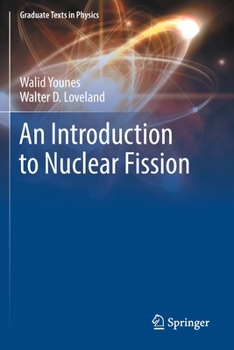An Introduction to Nuclear Fission
Select Format
Select Condition 
Book Overview
1. Introduction1.1. Why study fission?1.2. The discovery of fission1.3. The role of women in the development of the field 1.4. Early model of fission: the Bohr and Wheeler paper1.5. Structure of the book
2. Fission Systematics and General Characteristics2.1. Spontaneous and induced fission2.2. Chronology of the fission process2.3. Fission energetics2.4. Fission barriers2.5. Fission isomers2.6. Fragment mass and energy distributions2.7. Neutron distributions
3. Fission Models3.1. The liquid drop model3.2. The Strutinsky shell correction method3.3. Energy surfaces3.4. Transition state theory3.5.
4.1. Mass and charge distributions4.2. Kinetic energy distribution4.3. Angular momentum of fragments4.4. Angular distribution of fragments4.5. Decay of fragments: the Bateman equation
5. Fission Neutrons5.1. Scission and post-scission neutrons5.2. Prompt and delayed neutrons5.3. Neutron yield5.4. Neutron spectrum
6. Fission Gammas6.1. Prompt and delayed gammas6.2. Fission product yields from gamma-ray measurements6.3. Fragment angular momentum deduced from gammas6.4. Average gamma-ray energies and multiplicities6.5. Shape of the gamma-ray spectrum
7. Advanced Topics7.1. The Hartree-Fock approximation7.2. The treatment of pairing in the BCS approximation7.3. Constrained Hartree-Fock+BCS and energy surfaces7.4. The Generator Coordinate Method7.5. Fission dynamics: Semi-classical methods7.6. Fission dynamics: Quantum-mechanical methods7.7. The nucleus at and beyond scission7.8. Future directions in fission theory and experiments
2. Fission Systematics and General Characteristics2.1. Spontaneous and induced fission2.2. Chronology of the fission process2.3. Fission energetics2.4. Fission barriers2.5. Fission isomers2.6. Fragment mass and energy distributions2.7. Neutron distributions
3. Fission Models3.1. The liquid drop model3.2. The Strutinsky shell correction method3.3. Energy surfaces3.4. Transition state theory3.5.
4.1. Mass and charge distributions4.2. Kinetic energy distribution4.3. Angular momentum of fragments4.4. Angular distribution of fragments4.5. Decay of fragments: the Bateman equation
5. Fission Neutrons5.1. Scission and post-scission neutrons5.2. Prompt and delayed neutrons5.3. Neutron yield5.4. Neutron spectrum
6. Fission Gammas6.1. Prompt and delayed gammas6.2. Fission product yields from gamma-ray measurements6.3. Fragment angular momentum deduced from gammas6.4. Average gamma-ray energies and multiplicities6.5. Shape of the gamma-ray spectrum
7. Advanced Topics7.1. The Hartree-Fock approximation7.2. The treatment of pairing in the BCS approximation7.3. Constrained Hartree-Fock+BCS and energy surfaces7.4. The Generator Coordinate Method7.5. Fission dynamics: Semi-classical methods7.6. Fission dynamics: Quantum-mechanical methods7.7. The nucleus at and beyond scission7.8. Future directions in fission theory and experiments
Format:Paperback
Language:English
ISBN:303084594X
ISBN13:9783030845940
Release Date:November 2022
Publisher:Springer
Length:187 Pages
Weight:0.66 lbs.
Dimensions:0.4" x 6.1" x 9.2"
Related Subjects
Engineering Science Science & Math Science & Scientists Science & Technology TechnologyCustomer Reviews
0 rating





